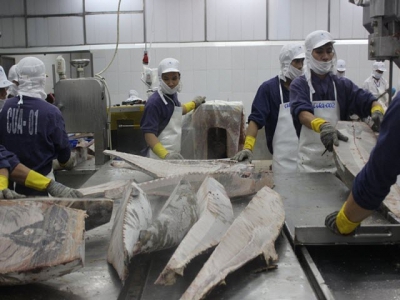Tuna export decrease in many markets

Besides exports to the EU, Israel and China declining, in August, tuna exports to Canada also declined.
Tuna exports are decreasing. Photo: T.H
Exports to EU fall
According to the Vietnam Association of Seafood Exporters and Producers (VASEP), in August 2019, Vietnam’s tuna exports has increased slowly. The value of tuna exports in August reached 65 million USD, increasing by 3% compared to the same period last year, bringing the total of value of exports in the first 8 months to 494 million USD.
The export growth to other markets in August is growing slowly. In addition to the decline in exports to the EU, Israel and China, tuna exports to Canada also showed signs of declining in August.
Vietnam's tuna exports to the EU have not improved. Tuna export value to this market continued to decrease over the same period, reaching only 96 million USD, down 6.3%.
However, it is praiseworthy that exports to Italy and Spain, the two largest tuna import markets in Europe, are increasing.
If Italy increases imports of fresh, frozen and dried tuna (excluding frozen tuna fillets) and other processed tuna (frozen steamed tuna), Spain tends to increase imports of canned tuna, tenderloin and frozen tuna fillets.
Meanwhile, tuna exports to the Netherlands continued to decline in August. This has affected the total value of tuna exports to this market in the first 8 months of this year, down 11.5%, reaching 15 million USD.
In August, Vietnam's tuna exports to ASEAN continued to increase. However, the growth is still not enough to compensate for the decline in the previous months, so the export value in the first 8 months of 2019 was only 33 million USD, down 0.9% over the same period last year. At present, Vietnam's export of frozen and dried fresh tuna to ASEAN is on the rise, while canned tuna exports have declined.
Expected increase not significant
With 31% growth in August, tuna exports to the US are very positive. As a result, the total value of tuna exports to the US in the first 8 months of 2019 increased by 56% compared to the same period in 2018. Export of tuna product groups of Vietnam to the US increased over the same period, except for fresh tuna, frozen and dried (excluding tenderloin, frozen tuna fillets).
Among product groups, frozen tuna fillet remains the largest proportion of Vietnam's total tuna exports to the US with 63%. Although taking a smaller share, exports of canned tuna products are growing rapidly.
Tuna exports to Japan in August continued to grow well, reaching 3.2 million USD, up 48% over the same period in 2018. In particular, the export of Vietnam’s tuna product groups to the US is now up over the same period, except for tenderloin and frozen tuna fillets. Notably, the group of canned tuna products has been on an increasing trend over the same period.
Greece is currently importing a lot of canned processed tuna from Vietnam. According to statistics of Vietnam Customs, the value of canned tuna exports to Greece took over 94% of the total value of Vietnamese tuna exports to this market.
Greece’s canned tuna imports also tended to recover after a decline in 2017. In 2018, Greece canned tuna imports recovered by 7% compared to 2017, reaching 6,511 tons with nearly double increase.
The supply of canned tuna for the Greek market is largely from intra-regional countries, taking 58% of total tuna imports of the country. In particular, Italy, the Netherlands and Spain are the three largest suppliers.
With the current tuna export situation, VASEP forecasts that tuna exports in the last months of the year will still increase but the growth will be at an average level.
Related news
 Value chains help Vietnamese tuna become more competitive
Value chains help Vietnamese tuna become more competitive Value chains, which involve fishing, processing and consumption of tuna, have helped Vietnamese tuna products gain competitive edge in more than 200 markets
 Bac Lieu province works to give its shrimp brands
Bac Lieu province works to give its shrimp brands The Mekong Delta province of Bac Lieu will work closely with FLC Group and Viet Uc Group to build and develop brands for local shrimp products
 The aquaculture pioneers who are embracing the renewable energy revolution
The aquaculture pioneers who are embracing the renewable energy revolution Given the potential impact that climate change could have on the aquaculture sector, it’s encouraging to note that several on-farm developments are currently